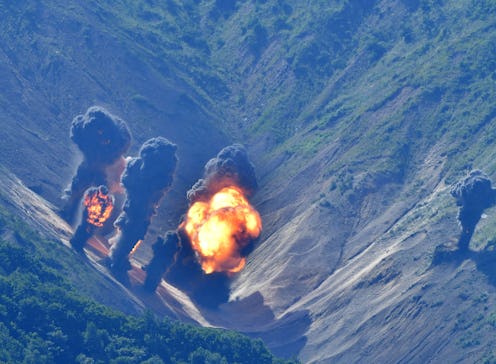News
North Korea Tested A Hydrogen Bomb, Its Most Destructive Nuclear Weapon Yet

On Sunday, North Korea reportedly tested a hydrogen bomb for a long-range missile, the latest in the recluse nation's continued efforts to pose a threat to Western nations like the United States. While experts remain uncertain about North Korea's actual capabilities, the reports from Sunday's test could suggest a concerning development: The difference between a hydrogen bomb and an atomic bomb could mean greater devastation in the event of an attack.
According to Reuters, North Korea's latest nuclear test was also its most powerful. The Kim Jong-Un regime reportedly launched a hydrogen bomb designed to be mounted on an intercontinental ballistic missile (ICBM). While there was no independent confirmation that the warhead launched on Sunday was, in fact, a hydrogen bomb, Reuters also reported that the test was 10 times more powerful than North Korea's last nuclear test and strong enough to register with international seismic agencies as a manmade earthquake.
It's not clear how powerful a hydrogen bomb developed by North Korea could be. In fact, according to CNN, some analysts still doubt North Korea's ability to actually fire such a powerful weapon. But if they do have a hydrogen bomb and the capability to make more, then some historical data could help Americans infer how powerful North Korea's arsenal could be.
CNN on Twitter Edit details… Replace media Remove media View media source
First, let's start with the similarities: Both atomic bombs and hydrogen bombs rely on nuclear power. In other words, they're both types of nuclear weapons. In practice, they can both be mounted on long-range missiles like ICBMs to be fired from a long distance, such as across an ocean.
The main difference between atomic bombs and hydrogen bombs is how they release nuclear energy. According to USA Today, atomic bombs use nuclear fission, where atoms split, to release energy. Hydrogen bombs, on other hand, use nuclear fusion, where atoms fuse together, to release energy. The process of fusion releases greater amounts of energy, which makes hydrogen bombs a bigger threat.
For perspective, the bombs dropped by the U.S. over Hiroshima and Nagasaki during WorldWar II were atomic bombs. According to USA Today, those atomic bombs released about 15 and 20 kilotons of explosive power, respectively. Meanwhile, the first hydrogen bomb tested by the U.S. in 1952, shortly after the bombings of Hiroshima and Nagasaki, released some 10,000 kilotons of explosive power.
Today's hydrogen bombs could be even more powerful. It's unclear what kind of power the North Koreans have at their disposal, but hydrogen bombs in general are capable of far more damage than atomic bombs. As a hydrogen bomb has never been dropped on an enemy target before, they're truly capable of more damage than the world has ever seen from a weapon.